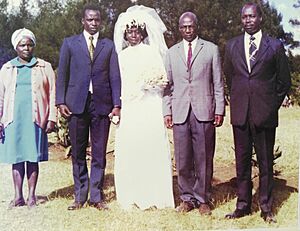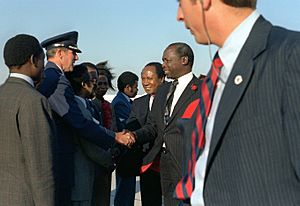Daniel arap Moi facts for kids
Quick facts for kids
Daniel arap Moi
CGH
|
|
|---|---|
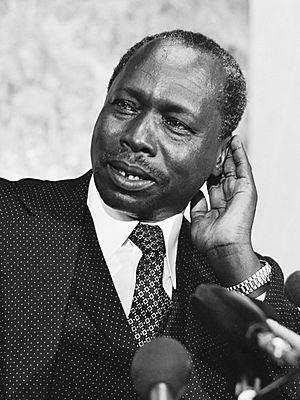
Moi in 1979
|
|
| 2nd President of Kenya | |
| In office 22 August 1978 – 30 December 2002 |
|
| Vice President |
|
| Preceded by | Jomo Kenyatta |
| Succeeded by | Mwai Kibaki |
| Chairperson of the OAU | |
| In office 24 June 1981 – 6 June 1983 |
|
| Preceded by | Siaka Stevens |
| Succeeded by | Mengistu Haile Mariam |
| 3rd Vice President of Kenya | |
| In office 5 January 1967 – 22 August 1978 |
|
| President | Jomo Kenyatta |
| Preceded by | Joseph Murumbi |
| Succeeded by | Mwai Kibaki |
| Minister for Home Affairs | |
| In office 28 December 1964 – 9 April 1978 |
|
| President | Jomo Kenyatta |
| Member of Parliament | |
| In office 5 December 1963 – 20 December 2002 |
|
| Succeeded by | Gideon Moi |
| Constituency |
|
| Personal details | |
| Born |
Toroitich arap Moi
2 September 1924 Sacho, Baringo, Kenya Colony |
| Died | 4 February 2020 (aged 95) Nairobi, Kenya |
| Political party |
|
| Spouse |
Lena Bomett
(m. 1950; sep. 1974) |
| Children | 8, including Gideon |
| Education | Kapsabet High School |
| Alma mater | Tambach TTC |
| Profession | Teacher |
| Awards | Silver World Award (1981) |
| Signature | |
Daniel Toroitich arap Moi (born September 2, 1924 – died February 4, 2020) was a very important Kenyan leader and politician. He served as the second president of Kenya from 1978 to 2002. He was Kenya's longest-serving president. Before becoming president, Moi was the third vice president of Kenya from 1967 to 1978 under President Jomo Kenyatta. He became president after Kenyatta passed away.
Moi was born into the Tugen group, part of the Kalenjin people, in the Kenyan Rift Valley. He went to the Africa Inland Mission school and then trained to be a teacher. He worked as a teacher until 1955. After that, he entered politics and was chosen to be a member of the Legislative Council for Rift Valley.
As Kenya was getting ready for independence, Moi joined the Kenyan group that went to London for the Lancaster House Conferences. There, they helped write Kenya's first constitution after independence. In 1960, he started the Kenya African Democratic Union (KADU) party. This party was a rival to Kenyatta's Kenya African National Union (KANU). After Kenya became independent in 1963, Kenyatta, who became the first Prime Minister and then President, convinced Moi to combine their two parties. Kenyatta then made Moi a minister in his government in 1964 and later promoted him to vice-president in 1967. Even though some powerful politicians from the Kikuyu group, sometimes called the Kiambu Mafia, didn't want him to be vice-president, Kenyatta kept Moi in that role. Moi became president when Kenyatta died in 1978.
At first, Moi was popular in Kenya and with Western countries. These countries saw his government as a way to balance the influence of countries like Ethiopia and Tanzania, which were allied with the Eastern Bloc. However, Moi's popularity dropped around 1990 as Kenya's economy struggled after the end of the Cold War. Because people protested and other countries put pressure on him, he had to allow elections with multiple political parties in 1991. He then led his party, KANU, to win the 1992 and 1997 elections. Many independent observers felt these elections were not completely fair. The constitution said Moi could not run for a third term. So, he chose Uhuru Kenyatta as his preferred successor. But Kenyatta lost to opposition leader Mwai Kibaki in the 2002 election. Kibaki then became president. Uhuru Kenyatta later won the presidency in the 2013 election.
Moi's government was seen by some as very strong and controlling, especially before 1992, when Kenya had only one political party. Organizations like Amnesty International and a special United Nations investigation raised concerns about how people's rights were treated during his presidency. After his presidency, investigations found that Moi and his sons were involved in significant cases of corruption, including the Goldenberg scandal in the 1990s.
Daniel arap Moi: Kenya's Longest-Serving President
Early Life and Becoming a Leader
Moi was born Toroitich arap Moi in a village called Kuriengwo in the Rift Valley. This area is now part of the Sacho division of Baringo County. His father, Kimoi arap Chebii, died in 1928 when Moi was only four years old. Not much is known about his mother, Kabon. His older brother, Tuitoek, became his guardian. Moi was one of the boys from Sacho chosen to join the new Africa Inland Mission (AIM) School in Kabartonjo in 1934. This school later moved to Kapsabet. He belonged to the Tugen sub-group of the Kalenjin people.
At the African Mission School, Moi became a Christian and took the name Daniel. He attended Tambach Teachers Training College from 1945 to 1947. This was after the colonial government did not allow him to enroll at Alliance High School. He later went to Kagumo Teacher's College and taught classes at Tambach Teacher's Training College. He then became the headmaster of a school in the Keiyo District. He worked as a teacher from 1946 until 1955.
In 1955, Moi started his political career when he was elected as a Member of the Legislative Council for Rift Valley. He was chosen to replace Dr. John ole Tameno. In 1957, Moi was re-elected. Moi was part of the Kenyan group at the Lancaster House Conferences in London. These meetings helped create Kenya's first constitution after independence. In 1961, he became the Minister of Education in the government before independence.
In 1960, he started the Kenya African Democratic Union (KADU) with Ronald Ngala. This party was an alternative to the Kenya African National Union (KANU) led by Jomo Kenyatta. KADU wanted a system where power was shared more, while KANU preferred a strong central government. KANU had more supporters, so Kenya's first constitution after independence focused on national unity with a central government.
Becoming Vice-President
After Kenya became independent on December 12, 1963, Kenyatta convinced Moi that KADU and KANU should merge. This was to complete the process of decolonization. So, KADU dissolved and joined KANU in 1964. The only real challenge to KANU's power came from the Kenya People's Union, starting in 1966. That party was banned in 1969. From then on, Kenya was mostly a one-party state, led by an alliance of the Kĩkũyũ and Luo groups.
Kenyatta wanted to gain support from the Kalenjin tribe, who lived in the fertile lands of the Rift Valley. He did this by first making Moi the Minister for Home Affairs in 1964. Then, he promoted him to Vice-President in 1967. Moi was from a smaller tribe, which made him an acceptable choice for the major tribes. Moi was elected to the Kenyan parliament in 1963 from Baringo North. From 1966 until he retired in 2002, he served as the Member of Parliament for Baringo Central, in addition to his other roles.
However, Moi faced opposition from some powerful Kikuyu politicians, who wanted one of their own to become president. They tried to change the constitution so that the vice-president would not automatically take power if the president died. But many senior Kikuyu politicians, including Mwai Kibaki and Charles Njonjo, and even Kenyatta himself, were against this change. They worried it could cause political instability if Kenyatta, who was old and often sick, passed away. So, Moi's position as Kenyatta's successor was protected.
His Time as President
When Jomo Kenyatta died on August 22, 1978, Moi became acting president. According to the Constitution, a special presidential election was to be held on November 8, 90 days later. However, a Cabinet meeting decided that no one else wanted to run for president. So, many politicians campaigned for Moi to be declared the winner without opposition. He was sworn in as the second President of Kenya on October 14, 1978.
At first, Moi was very popular across the country. He traveled around Kenya and met many people, which was different from Kenyatta's style of governing from behind closed doors. However, he still had to follow the government system Kenyatta had created, which gave the president almost total power. Despite his popularity, Moi still needed to fully secure his power. From the start, being against communism was important for Moi's government. Vice-President Mwai Kibaki clearly stated, "There is no room for Communists in Kenya."
On August 1, 1982, some Air Force members, led by Hezekiah Ochuka, and supported by university students, tried to overthrow Moi's government. This attempt was quickly stopped by the military and police forces. Moi used this opportunity to remove political opponents and strengthen his power. He reduced the influence of Kenyatta's former allies in the government. He appointed his supporters to important positions. He also changed the constitution to officially make KANU the only legal party in Kenya. However, this didn't change much, as all other major opposition parties had been banned since 1969.
Kenyan scholars and thinkers did not accept this. Educational institutions became places where people wanted to bring in democratic reforms. However, Kenyan secret police entered these groups, and many members had to leave the country. The teaching of Marxism was no longer allowed at Kenyan universities. The remaining opposition at home went underground.
Challenges and Changes
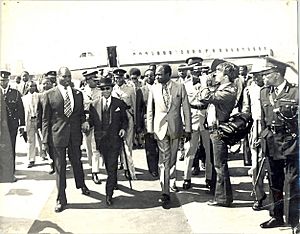
Starting in the late 1980s, Moi's government faced new challenges. The Cold War was ending, and Kenya's economy was struggling due to rising oil prices and falling prices for farm products. Western governments also became less friendly towards Moi's KANU government. This was a change from the Cold War period, when Kenya was seen as important for keeping stability in the region and stopping the spread of Soviet influence. During that time, Kenya received a lot of foreign aid. It was accepted as a stable, though strict, government with Moi and KANU in charge. Western allies often overlooked the increasing political control.
With the fall of the Soviet Union, Western countries no longer needed Kenya as much to counter socialist influence. Their policy towards Moi changed. They started to see him more as a strict ruler. Foreign aid was stopped until Kenya agreed to economic and political reforms. One of the main conditions, especially from the United States, was to bring back a multi-party system. Even though Moi wasn't keen on this, he managed to convince his party, who were against the reform. Moi announced that he would remove the law that banned opposition parties at a KANU conference in Kasarani in December 1991. Despite strong debate, the conference agreed to the change.
Elections and Staying in Power
Even with opposition parties, Moi and KANU won the first multi-party elections in 1992 and again in 1997. Both elections had some disagreements and unrest. Moi cleverly used Kenya's different ethnic groups to his advantage. He gained votes from various smaller tribes and the Luhya, and he benefited from fears that the Kikuyu group might dominate. Because the opposition was not united, Moi won easily. Although some suspected election fraud, the main reason for his victories was a divided opposition. In 1992, he got 36.3% of the votes, and in 1997, he received 40.4%. Both were comfortable wins because the opposition groups split their votes and failed to put forward a single candidate.
Facing Criticism and Money Issues
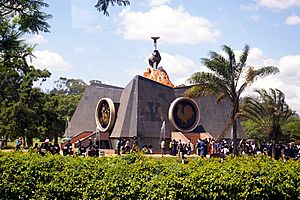
In 1999, reports from groups like Amnesty International and a special United Nations investigation showed that there were concerns about human rights in Kenya under Moi's government.
Moi was also linked to the Goldenberg scandal in the 1990s. In this case, the Kenyan government paid out a lot of money for gold exports, even though Kenya has very little gold. The gold was actually smuggled from Congo. The Goldenberg scandal cost Kenya a huge amount of money, more than 10% of the country's yearly economic output.

Investigations into these issues started at the request of foreign countries that gave aid. However, they didn't lead to much during Moi's presidency. When Mwai Kibaki became president, he reopened the investigation. As the inquiry continued, Moi, his two sons, Philip and Gideon (who is now a Senator), and his daughter, June, along with many other high-ranking Kenyans, were mentioned. In July 2003, a Treasury official said that in 1991, Moi ordered him to pay a large sum of money to Goldenberg, which was against the laws at the time.
Wangari Maathai spoke about Moi's actions in the 1980s and early 1990s. She said he tried to stop the Greenbelt Movement after she spoke out against the government's plans to build an office tower in Uhuru Park. Maathai said Moi's actions included removing the Greenbelt Movement from their government offices and trying to cut off their funding from international donors. Maathai also mentioned Moi's tactics when the multi-party movement began in the 1990s. She said Moi announced the military would take over the government before the December 1992 elections.
In October 2006, the International Centre for Settlement of Investment Disputes found that Moi had accepted money from a Pakistani businessman. This was to give the businessman a special right to run duty-free shops at Kenya's international airports in Mombasa and Nairobi. The businessman claimed he paid Moi US$2 million in cash for this approval.
On August 31, 2007, WikiLeaks published a secret report. It showed how Moi's close associates used many shell companies and secret trusts to move hundreds of millions of pounds into nearly 30 countries.
Life After Presidency

Moi was not allowed by the constitution to run in the 2002 presidential elections. Some of his supporters suggested changing the constitution so he could run for a third term. But Moi chose to retire. He picked Uhuru Kenyatta, the son of Kenya's first President, as his preferred successor. However, Mwai Kibaki was elected president by a large majority over Kenyatta on December 29, 2002. Moi handed over power in a ceremony where a huge crowd in Nairobi was openly unfriendly towards him.
After leaving office in December 2002, Moi lived in retirement. He was mostly avoided by the political leaders. However, he still had some popularity with ordinary people, and his presence always drew a crowd. He spoke out against a proposed new constitution in 2005. Moi believed the document was against what the Kenyan people wanted. After the proposal was defeated in a November 2005 referendum, President Kibaki called Moi to discuss the way forward.
On July 25, 2007, Kibaki appointed Moi as a special peace envoy to Sudan. Kibaki mentioned Moi's "vast experience and knowledge of African affairs" and his "stature as an elder statesman." As a peace envoy, Moi's main job was to help bring peace to southern Sudan, where an agreement signed in early 2005 was being put into action. At that time, the Kenyan press thought Moi and Kibaki might be planning an alliance before the December 2007 election. On August 28, 2007, Moi announced he supported Kibaki's re-election and would campaign for him. He criticized the two opposition groups, saying they were based on tribes.
Moi owned the Kiptagich Tea Factory, which started in 1979. This factory was involved in some controversy. In 2009, the government threatened to close it during the Mau Forest evictions.
Family Life
Moi was married to Lena Bomett from 1950. They separated in 1974, before he became president. Lena's parents were early Christians in Eldama Ravine. They respected Moi, who was a young, tall, and well-behaved orphan boy.
Moi often stayed with the Bometts during school holidays because his home was 160 kilometers away. He also stayed with the Christian family of Isaiah Chesire.
In 1950, after leaving Kagumo Teacher's College, Moi married Lena in a church wedding. He paid two heifers, one ox, and four sheep to the Bomett family. Moi's long-time friend, Francis Cherogony, was the best man. After marrying, Lena stopped her teaching career to raise her family. She settled with Moi at Tambach Government School, where their first two children, Jennifer and Jonathan Kipkemboi, were born in 1952 and 1953.
Daniel arap Moi had eight children: five sons and three daughters. Among them are Gideon Moi, who also became a politician in Kenya, and the late Jonathan Toroitich (a former rally driver, who died in 2019), and Philip Moi (a retired army officer). His older and only brother, William Tuitoek, died in 1995. Moi was a lifelong member of the Africa Inland Mission Church.
Moi was the founder and supporter of many important schools in Kenya. These include Moi Educational Centre, Kabarak High School, Kabarak University, Sunshine Secondary Schools, and Sacho Primary and Secondary.
His Passing
In October 2019, President Moi was admitted to The Nairobi Hospital in serious condition due to lung complications. He was discharged in November 2019 but was hospitalized again days later for knee surgery. He then had breathing problems and underwent a tracheotomy. A month later, he suffered from internal bleeding, which led to multiple organ failure, and he was put on life support.
Moi passed away at The Nairobi Hospital on the morning of February 4, 2020, at the age of 95. His family was with him. Moi's body lay at the Parliament building for public viewing for three days, from February 8 to February 10, 2020. A state funeral service was held at Nyayo Stadium on February 11, 2020. He was buried at his home in Kabarak, Nakuru county, on February 12, 2020. His burial included military honors, such as a 19-gun salute and a missing man formation flyby. His grave is next to his former wife, Lena Bomett.
What is Named After Him?
Many places and institutions in Kenya are named after Daniel arap Moi, including:
- Moi Teaching and Referral Hospital
- Moi Air Base, Nairobi
- Moi International Airport, Mombasa
- Moi International Sports Centre, Kasarani, Nairobi
- Moi Stadium, Kisumu
- Moi University, Eldoret
- Roads and streets:
- Moi Avenue (Mombasa)
- Moi Avenue (Nairobi)
- A number of schools, such as Moi Girls High School, Eldoret.
Images for kids
-
Moi with Queen Juliana and Prince Bernhard during his state visit to the Netherlands in June 1979
See also
 In Spanish: Daniel arap Moi para niños
In Spanish: Daniel arap Moi para niños


